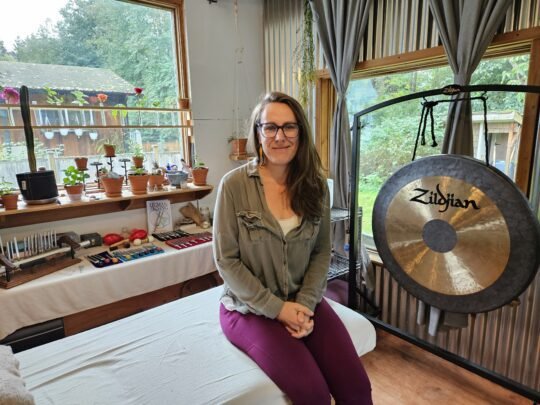
Kirstin French’s path to healing began with curiosity and reflection. She was in her 20s when she saw a co-worker in Sechelt smudge an office space. Smoke filled the room as the woman moved about, clearing the energy in a practice common to Indigenous and traditional cultures worldwide. When the ritual was over, the woman turned to Kirstin and asked if she could feel the difference in the room.
“I had no idea what she meant,” Kirstin recalls, smiling. “But I wanted to understand what she was talking about and feel those subtle energies.”
French grew up in the 1980s in Squamish in a milieu that was at several removes from the esoteric knowledge systems of the East. Though modern Western science squarely rejected their existence, subtle energies and their possibility undergird most of the healing modalities of the East. French had been practicing yoga postures or asanas since her 20s. Still, it wasn’t until she encountered Kriya Yoga that she began to unravel the deeper dimensions of yoga, which now inform her practice of Yoga Nidra.

Kriya Yoga also took her to India, where she practiced yoga and meditation with a realized master, Paramahamsa Prajnanananda. This helped her understand that yoga is more than callisthenics. A brave new world of energy healing has since opened for her.
“Yoga helped me understand individual and collective consciousness, karmic repercussion, and it has enabled me to understand what love is and how it can be interchangeably used for God.” It has also allowed her to help others with guided meditation and yoga nidra sessions, whose goal is to give us good, restorative sleep but also access to the depths of our consciousness during this process. In teaching us how to be fully present, Yoga Nidra allows us to be fully present, even in the quiet depths of sleep.
The Art of Conscious Rest: Guiding Others Through Yoga Nidra
For Kirstin, Yoga Nidra became more than just a practice—it’s a way of life. “Yoga Nidra is about being aware as the body falls asleep,” Kirstin explains. “It’s this delicate balance where the mind remains present even as the physical body rests.”

“People are exhausted,” she says. “We live in a world where rest is undervalued. So many of my clients come to me because they’ve heard Yoga Nidra can help them sleep better, and it absolutely can.”
In her sessions, Kirstin guides her clients through the layers of consciousness, using a process rooted in ancient yogic philosophy. “We start with the koshas, or sheaths of the self,” she explains. “The outermost layer is the physical body, and then we move deeper into the breath, the mind, the emotions, and finally into bliss—the innermost core of our being.”
Her voice is gentle and deliberate as she leads clients through these stages, helping them move into slower brainwave states, where the subconscious mind becomes more accessible. “It’s in these states that the body gets the deep rest it needs to heal,” she says. “But beyond rest, we also have the opportunity to confront the parts of ourselves that we usually keep buried—the fears, the memories, the emotions.”
For Kirstin, this work is deeply personal. “In Yoga Nidra, we’re essentially practicing how to die. But in doing that, we also learn how to live more fully. By staying conscious during these deeply restful states, we become more aware in our waking lives. We learn to pay attention—not just to the big things, but to the subtle sensations, the nuances of how we feel in any given moment.”
Kirstin’s practice has evolved to include sound healing, a modality that, like Yoga Nidra, works on the subtle layers of the body and mind. She discovered this approach when collaborating with a sound healer who played the didgeridoo and tuning forks during a session. “The sound was so striking,” she says, “especially when he spiralled two tuning forks together. I’d never experienced anything like it.”
That experience led Kirstin to train in sound healing, focusing on tuning forks to enhance her work. “Sound healing penetrates deep into the body’s energetic field,” she explains. “When I combine it with Yoga Nidra, it helps clients access an even deeper level of rest and healing.”
Her in-person or online sessions are a journey, from the physical to deeper dimensions of personality. She allows space for the subconscious to emerge after guiding clients through the koshas and pairing the practice with sound. One-on-one sessions are particularly intuitive. “I never plan them,” she says. “I ask for guidance before we begin, and then the session unfolds as it’s meant to.”
Kirstin trusts her intuition completely, even when it seems at odds with logic. She recounts a time when she was working with a client who had recently been diagnosed with diabetes. “I was strongly called to play the creativity protocol with the tuning forks,” she recalls, “which didn’t make sense for a health-related issue. But after the session, the client told me that creativity had been on her mind—she just hadn’t mentioned it because she thought it wasn’t ‘responsible’ given her diagnosis.”
This ability to connect with her clients on such a deep level is something Kirstin attributes to her own practice of Yoga Nidra. “As I’ve developed my awareness in Yoga Nidra, it’s filtered into my everyday life. I’m more present in my relationships, more in tune with my body’s needs, and much more trusting of my intuition.”




